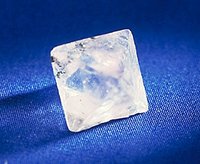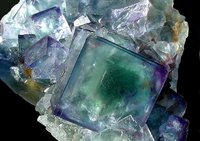Fluorite/Fluorspar
Contents
Background
 Fluorite. (Source: Mineral Information Institute)
Fluorite. (Source: Mineral Information Institute) When found in nature, fluorspar is known by the mineral name fluorite. Fluorspar (fluorite) is calcium fluoride (CaF2). It is found in a variety of geologic environments. Fluorspar is found in granite (igneous rock), it fills cracks and holes in sandstone, and it is found in large deposits in limestone (sedimentary rock). The term fluorspar, when used as a commodity name, also refers to calcium fluoride formed as a by-product of industrial processes.
Fluorspar is relatively soft, number 4 on Mohs' scale of hardness. Pure fluorspar is colorless, but a variety of impurities give fluorite a rainbow of different colors, including green, purple, blue, yellow, pink, brown, and black. It has a pronounced cleavage, which means it breaks on flat planes. Fluorite crystals can be well formed, beautiful and highly prized by collectors.
Despite its beauty and physical properties, fluorspar is primarily valuable for its fluorine content.
Name
Even though fluorite contains the element fluorine, its name is not derived from its chemical composition. The name was given by Georg Agricola in 1546 and was derived from the Latin verb fluere which means to flow because it melts easily. Spar is a generic name used by mineralogists to refer to any non-metallic mineral that breaks easily to produce flat surfaces and which has a glassy luster.
A miner’s name used long ago for fluorite was Blue John.
Sources
 More Fluorite crystals. (Source:Cochise College)
More Fluorite crystals. (Source:Cochise College) The United States once produced large quantities of mineral fluorspar. However, the great fluorspar mines of the Illinois-Kentucky fluorite district are now closed. Today, the United States imports fluorspar from China, South Africa, Mexico, and other countries.
A small percentage of the fluorspar consumed in the United States is derived as a by-product of industrial processes. For instance, an estimated 5,000 to 8,000 tons of synthetic fluorspar is produced each year in the uranium enrichment process, the refining of petroleum, and in treating stainless steel. Hydrofluoric acid (HF) and other fluorides are recovered during the production of aluminum.
Uses
The majority of the United States’ annual consumption of fluorspar is for the production of hydrofluoric acid (HF) and aluminum fluoride (AlF3). HF is a key ingredient for the production of all organic and non-organic chemicals that contain the element fluorine. It is also used in the manufacture of uranium. AlF3 is used in the production of aluminum.
The remainder of fluorspar consumption is as a flux in making steel, glass, enamel, and other products. A flux is a substance that lowers the melting temperature of a material.
Substitutes and Alternative Sources
Phosphoric acid plants, which process phosphate rock into phosphoric acid, produce a by-product chemical called fluorosilicic acid. This is used to fluoridate public water supplies or to produce AlF3. Phosphate-rich rocks are a minor alternative source for elemental fluorine.
Further Reading
- Common Minerals and Their Uses, Mineral Information Institute.
- More than 170 Mineral Photographs, Mineral Information Institute.
| Disclaimer: This article is taken wholly from, or contains information that was originally published by, the Mineral Information Institute. Topic editors and authors for the Encyclopedia of Earth may have edited its content or added new information. The use of information from the Mineral Information Institute should not be construed as support for or endorsement by that organization for any new information added by EoE personnel, or for any editing of the original content. |